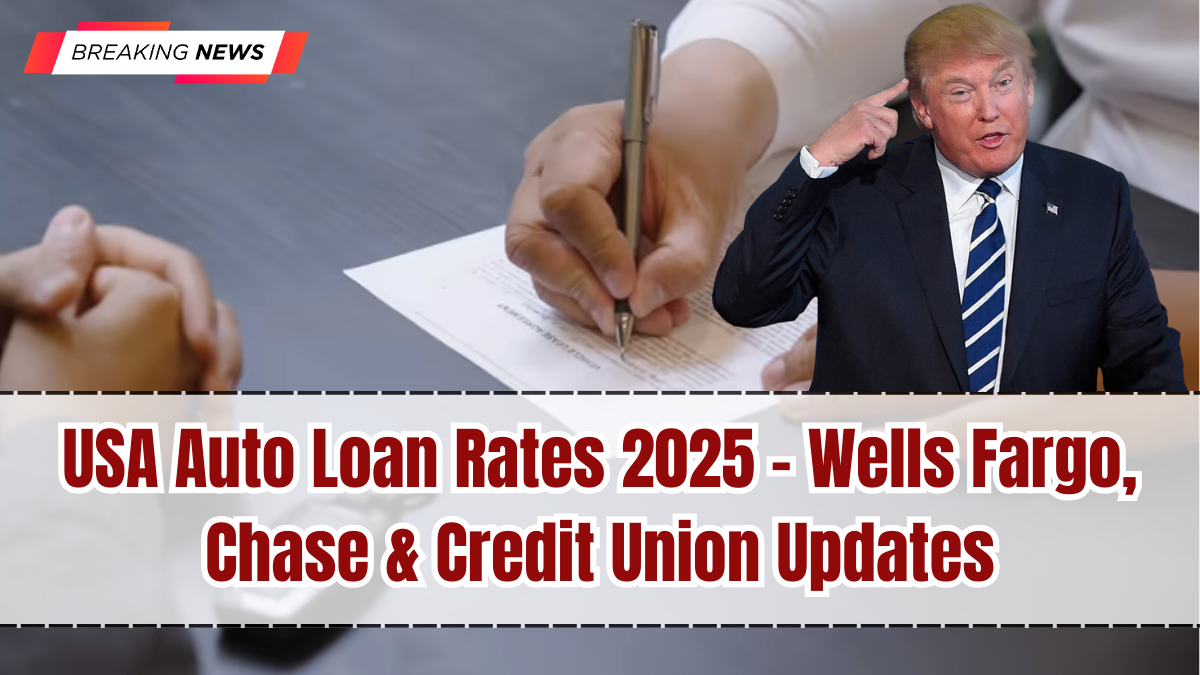Financing a vehicle has become more challenging in 2025, as Americans face record-high borrowing costs. The USA Auto Loan Rates 2025 report shows that interest rates from major banks and credit unions are at their steepest levels in over a decade, leaving many buyers reconsidering whether to purchase, lease, or delay a new vehicle. With household budgets already stretched by rising fuel, insurance, and maintenance costs, higher loan rates are reshaping the auto market across the country.

Why Auto Loan Rates Are So High
The rise in auto loan rates stems from several factors:
-
Federal Reserve Policy – Interest rates remain elevated as the Fed works to control inflation.
-
Inflationary Pressure – Rising costs for vehicles, parts, and labor make auto financing more expensive overall.
-
Lender Risk – Banks have tightened lending criteria, pricing higher risk into loans.
-
Consumer Demand – Despite high rates, demand for cars, especially SUVs and EVs, remains steady, giving lenders little incentive to reduce rates.
Together, these factors have pushed the national average auto loan rate for new vehicles to 7.9% APR, while used vehicle loans average 9.5% APR in 2025.
Wells Fargo Auto Loan Rates in 2025
Wells Fargo, one of the largest auto lenders in the US, has updated its financing terms:
-
New Car Loans: Starting at 7.5% APR for borrowers with excellent credit.
-
Used Car Loans: Around 9.0% APR, reflecting higher risk.
-
Loan Terms: Up to 72 months, with longer terms available but at higher rates.
-
Special Offers: Discounts for existing Wells Fargo banking customers and those using dealer-partner programs.
Wells Fargo has also invested in digital auto financing platforms, making applications and approvals faster, though stricter credit requirements mean fewer borrowers qualify for the lowest advertised rates.
Chase Auto Loan Rates in 2025
Chase Bank continues to be a major player in auto financing, partnering with dealerships nationwide. Its USA Auto Loan Rates 2025 updates include:
-
New Car Loans: Starting at 7.7% APR for prime borrowers.
-
Used Car Loans: Averaging 9.3% APR, depending on the vehicle’s age and mileage.
-
Flexible Terms: Between 36–84 months, though longer terms may exceed 10% APR.
-
EV Financing Incentives: Select EV purchases financed through Chase include a 0.5% APR discount.
Chase emphasizes its nationwide dealer network, making it easier for buyers to secure financing directly at dealerships. However, higher borrowing costs mean monthly payments are significantly steeper compared to just a few years ago.
Credit Union Loan Rates in 2025
Credit unions remain a popular choice for borrowers looking for lower rates compared to big banks. Many credit unions continue to undercut national averages, though rates have also risen in 2025:
-
New Car Loans: Typically range from 6.8%–7.2% APR for members with strong credit.
-
Used Car Loans: Around 8.0%–8.8% APR, still cheaper than most banks.
-
Flexible Terms: Up to 84 months, with fewer penalties for early repayment.
-
Member Benefits: Credit unions often offer bundled discounts, such as lower insurance or fee waivers.
The USA Auto Loan Rates 2025 data shows that borrowers with access to credit unions can save thousands of dollars over the life of a loan compared to traditional banks.
Impact on Buyers
The sharp rise in auto loan rates means that the cost of financing a vehicle has increased dramatically. For example, financing a $40,000 vehicle at 7.9% APR over 72 months results in monthly payments of about $700, with total interest costs exceeding $10,000.
This has led many buyers to:
-
Delay new vehicle purchases.
-
Opt for smaller, more affordable models.
-
Consider leasing instead of financing.
-
Choose longer loan terms, despite higher lifetime costs.
The USA Auto Loan Rates 2025 environment is forcing consumers to rethink how they approach vehicle ownership.
How to Reduce Loan Costs
Experts recommend several strategies for borrowers facing high rates:
-
Improve your credit score before applying, as even small improvements can secure lower APRs.
-
Make larger down payments to reduce principal loan amounts.
-
Shop around between banks, credit unions, and online lenders.
-
Consider refinancing later if interest rates fall in the future.
-
Explore EV incentives that offer reduced loan rates or tax credits.
By carefully planning, buyers can minimize the impact of record-high financing rates.
Market Outlook
Analysts expect auto loan rates to remain elevated for most of 2025. If inflation slows and the Federal Reserve cuts interest rates in late 2025 or 2026, borrowers could see relief. However, banks are likely to remain cautious, meaning credit unions and online lenders may continue offering the best deals.
The USA Auto Loan Rates 2025 highlight how affordability challenges are reshaping the automotive market, with financing now as important a factor as vehicle choice itself.
FAQs
What is the average auto loan rate in the USA in 2025?
New car loans average 7.9% APR, while used car loans average 9.5% APR.
Which bank offers the best auto loan rates in 2025?
Credit unions typically offer lower rates, averaging 6.8–7.2% APR for new car loans.
Do longer loan terms reduce costs?
They reduce monthly payments but increase total interest paid, making vehicles more expensive over time.
Are there special offers for EV financing?
Yes, some banks like Chase offer 0.5% APR discounts for electric vehicle loans.
Will auto loan rates drop in 2025?
Experts predict rates will remain high through most of 2025, with possible easing in late 2025 or 2026.
Click here to know more.
